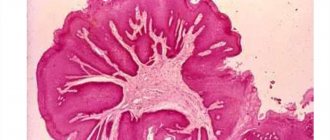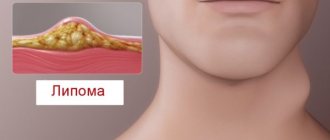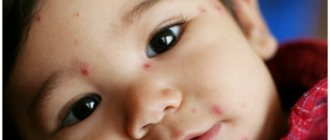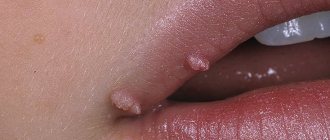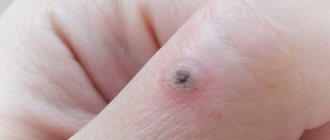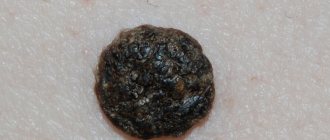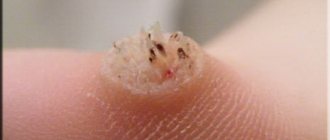HPV and its types
HPV (human papillomavirus) is the common name for a large group of viruses, numbering up to 70 names. Viruses differ from each other in their DNA structure. Their similarity lies in the fact that they cause various formations on the skin or mucous membranes, the localization of the formation depends on the type of virus.
Let's look at the main diseases caused by the papilloma virus:
- Warts are the most common type of papillomas. They appear in the form of round and dense skin formations. Painless and safe. They are purely an aesthetic defect.
- Genital condylomas are papillomas that occur on the genital organs: on the male penis and on the female labia.
- Bowenoid papulosis - the disease is a rash on the genitals. It occurs in both men and women. This type of papillomas is unsafe - cases of development into skin cancer have been reported.
- Bowen's disease develops only in men. The formation is localized on the head of the penis in the form of a bright plaque. Often people do not give due importance to this education, but in vain: malignancy is possible.
- Precancerous condition of the cervix. There are three stages of this disease. Moreover, the latter is the initial stage of cancer. It is practically asymptomatic. The causative agent is HPV type 18 or 16.
- Cervical cancer is the main danger of papillomas! Caused by HPV types 16, 18, 33, 35 and 39. Unfortunately, it is asymptomatic for quite a long time, complaints arise at serious stages. This once again indicates the need to visit a gynecologist 2 times a year.
Papillomas are not the harmless skin diseases that they seem at first glance. It is necessary to monitor the condition of your skin and mucous membranes, and incomprehensible formations must be shown to a doctor.
Treatment
As a rule, treatment of papillomas in the oral cavity occurs using two main methods:
- by medicinal method;
- surgical removal of papillomas.
The medicinal method involves the use of immunostimulating and antiseptic drugs. Drugs whose main purpose is to strengthen the immune system neutralize the impact of HPV on the patient’s body and reduce the risk of relapse. As a rule, drug therapy is accompanied by taking vitamins, as well as an appropriate diet.
Antiseptic treatment involves the external application of special gels and ointments to the papilloma. This helps reduce the impact of bacteria living in the oral cavity on the lesion and speed up recovery.
Surgical treatment involves a radical way to solve the problem, by excision of the tumor. This type of therapy has a high success rate. After it, the oral mucosa is quickly restored, acquiring its original appearance.
Papilloma on the oral mucosa is removed in 2 ways:
- laser treatment;
- radio wave excision.
For greater effectiveness, many otolaryngologists recommend complex treatment, consisting of taking medications in the initial stages of therapy, followed by surgical removal of the tumor.
Treatment does not eliminate HPV, but it is quite possible to reduce its activity. Drug therapy should be combined with surgical removal of growths. In the presence of small tumors, local treatment is used, which involves regular treatment with an oil solution of vitamin A.
In parallel, it is recommended to use interferons that reduce the activity of the virus in the affected area. A monthly therapeutic course allows you to get rid of small papillomas.
The use of antiviral drugs is considered no less effective. Treatment of tongue papillomatosis during pregnancy can be complicated by a physiological decrease in immunity and the inability to use standard medications.
In this case, it is recommended to get rid of growths with the help of immunostimulants: Kipferon, Viferon. These drugs increase the body's ability to cope with viruses. Folk remedies are also used in the treatment of papillomatosis.
Surgical
The method of surgical removal is selected depending on the location of the tumor and the individual characteristics of the human body:
- Laser exposure is the most effective and safe method. It is characterized by a short recovery period and the absence of complications. The main disadvantage of laser removal is its high cost.
- Electric cauterization is currently practically not used due to pain and a long rehabilitation period.
- Radio wave destruction is the destruction of papillomas by exposure to waves of a certain frequency. There is practically no pain, the recovery period is short.
- Cryodestruction is the removal of papilloma on the tongue using liquid nitrogen. The papilloma tissue is frozen, causing it to die within a few days.
- Classic surgical interventions are prescribed if histological analysis is necessary.
In rare cases, the growth may disappear spontaneously without surgery. This becomes possible by increasing immunity, which you can achieve on your own. Exercise, hardening, taking vitamins and proper nutrition help with this.
ethnoscience
Is it possible to get rid of papilloma at home? You should not try to remove the growth on your tongue yourself by cauterization or cutting. Such actions are considered the main causes of malignant degeneration of papilloma or blood poisoning. Treatment of the disease can begin only after determining the type of papilloma.
The basis of treatment is strengthening the immune system. Papillomas in most cases are provoked by a decrease in immunity and in order to forget about them for a long period, you need to fight the cause of the disease.
The use of alternative medicine recipes does not imply abandonment of traditional methods of treatment:
- Potatoes If growths have affected the frenulum or the root of the tongue, it is recommended to rinse your mouth and throat with potato juice obtained from red tubers. Treatment should last at least 2 months. In the presence of damaged papillomas, tincture of potato sprouts is used. Papillomatosis should be treated with this remedy until the pain disappears.
- Decoction In order to cure growths on the tongue, you need to consume one glass of decoction every day from rose hips, echinacea flowers and medicinal herbs (fresh nettle, horsetail, fresh plantain leaves, flowering dandelion roots, lemon balm leaves).
You may be interested in the following article: “Removal of papillomas on the face with a laser.”
Treatment with chicken eggs
Removing papillomas on the tongue at home is quite easy to do using the most common chicken eggs. This method is one of the most effective.
For the procedure, only egg white is used. It must be spread on the area of the tongue affected by the growth. Saliva breaks down the protein after a few minutes, so it needs to be applied for an hour every 15 minutes. The procedure should be repeated three times a day.
The duration of therapy is on average up to 10 days; upon completion, the growths die and fall off.
Castor oil treatment
Quick and effective treatment of tongue papilloma at home can be achieved using ordinary castor oil, which consists of acids that are harmful to skin formations caused by HPV.
New growths must be lubricated with castor oil twice a day. A piece of cotton wool is soaked in oil and applied to the affected area for 25-35 minutes. The duration of such therapy is about a week.
Treatment with kerosene-nut ointment
Papillomas on the tongue can be cured using a folk remedy such as kerosene-nut ointment. It can be prepared as follows:
- still green walnuts must be ground in a meat grinder or blender;
- the resulting mass should be placed in a glass container (it is best to take a jar) and filled with purified kerosene in a ratio of 2 to 1;
- the mixture should infuse for 3 weeks;
- The finished tincture must be filtered and the remaining raw materials squeezed out.
The ointment should be stored in a dark and cool place. The growths on the tongue need to be lubricated with nut-kerosene ointment 1-2 times a day.
Herbal treatment
One of the most effective and popular ways to combat papillomas is the use of celandine, the juice of which destroys tumors. Use fresh stems or leaves of this plant, as well as ready-made juice or infusion, which can be purchased at the pharmacy.
Celandine juice burns the skin, so it must be applied pointwise to the growths.
The procedure should be repeated after two days three times a week, after which the formations dry out and fall off.
You can also prepare a tincture from the leaves (or squeezed juice) of celandine (you can also use string and chaga). The resulting liquid must be poured into ice trays and placed in the freezer. Every day, apply an ice cube to the growth 3 times and hold for about 3 minutes. Only after the growths have fallen off can the procedure be repeated.
You can also use the following recipes to treat growths on the tongue:
- Aloe or Kalanchoe. It is necessary to cut a leaf from a plant that is older than 5 years and apply it to the growth, securing it with a bandage. Aloe leaf must be kept for 3-4 hours, and Kalanchoe – at least 5 hours. Duration of treatment – 10 days.
- Banana. It is recommended to wipe the tumor with a banana peel 5-6 times a day. This product does not have a quick effect, so the result will be visible after a few weeks. However, this method of therapy is very safe.
- Dandelion heads. Place dandelion heads tightly into a glass jar and fill with triple cologne. The product must infuse for 14 days, after which it is filtered. Apply dandelion infusion to the growth several times a day until it completely disappears.
- Rowan juice. It is necessary to squeeze out the juice from fresh berries, which must be used to wipe the tongue every hour until the formation completely disappears. Wormwood juice has a similar effect.
- Chestnut infusion. You need to pour boiling water over half a glass of chestnut and leave for 6 hours. The resulting infusion is drunk in small sips, holding it in the mouth for a few seconds. The course of treatment is 2 weeks.
- Garlic balls. You need to mash a clove of garlic and mix it with flour, forming a ball. It must be glued to the papilloma on the tongue for 2 hours. During the procedure, a strong burning sensation will be felt. The growth will dry out in a couple of weeks.
Aggressive Treatment Methods
Traditional medicine offers aggressive methods for treating tumors on the tongue, which are very effective, but they must be used with great caution.
These methods include:
- Ammonia. You need to dip a cotton swab in the product and apply it to the papilloma for 5 seconds. At this time, the tongue should be stuck out. Next, you need to stand like this for 5 minutes and rinse your mouth with warm water without swallowing it.
- Laundry soap. You need to stick out your tongue and lubricate the growth with a bar of soap. Then you need to hold your tongue out for 10 minutes. After this, a patch is applied to the affected area. It is not recommended to do this procedure at night because the patch may enter the respiratory tract. The procedure should be done twice a day until the growth disappears.
We looked at how to treat papillomas on the tongue with traditional recipes, but before using them it is recommended to consult a doctor.
Important! It is worth remembering that self-medication can significantly worsen the situation and lead to the transformation of the growth into a cancerous tumor.
Methods of infection with HPV
You can become infected with HPV in various ways.
Among them:
- Any unprotected sexual intercourse
- Genital-oral method
- Household method
- Using other people's personal hygiene products
- Mucosal contact
- Salivary fluid contact
- Through kisses (if one of the partners has the virus on their lips)
- Contact of a scratch or abrasion of a healthy person with the mucous membranes of an infected person
People who frequently change sexual partners are at risk. Most often, a woman catches the infection from a man.
A common situation is when a man is a carrier of a dangerous disease, but does not get sick. For women, the disease is dangerous because it occurs in the active phase and can lead to cancer of the genital organs.
To prevent the development of dangerous papillomas on the mucous membranes, it is necessary to use barrier methods of contraception (condoms). Also avoid promiscuity and observe personal hygiene rules.
Treatment and prognosis of benign tumors of the tongue
Considering the constant chemical (under the influence of saliva) and mechanical trauma to tongue tumors, which can lead to their malignancy, preference is given to radical treatment tactics - removal of the tumor within healthy tissue. The decision to remove the struma of the tongue is carried out jointly with an endocrinologist after examining the level of thyroid hormones.
Removal of a tongue tumor, depending on its type and size, can be performed using the radio wave method, surgical excision, electrocoagulation, laser removal, or cryodestruction. For vascular tumors of the tongue, sclerotherapy can be used.
Benign tumors of the tongue, when removed in a timely manner before malignant transformation occurs, have a favorable prognosis. However, some of them, especially hemangiomas and lymphangiomas, tend to recur.
- What are Benign Tongue Tumors?
- Symptoms of Benign Tongue Tumors
- Diagnosis of Benign Tumors of the Tongue
- Treatment of Benign Tongue Tumors
- Prevention of Benign Tongue Tumors
Causes of papillomas on the tongue
The oral cavity also refers to the mucous membranes of our body. Therefore, papilloma on the tongue is no exception to the rule.
Papilloma on the tongue is almost impossible to miss. Discomfort, burning, pain are localized at a specific point on the tongue. A person goes to the mirror, looks at the disturbing area and discovers a small white growth that looks like a purulent pimple. The formation resembles cauliflower to the touch.
The main cause of papillomas on the tongue is human infection with HPV.
There are a number of reasons for this:
- Weakened immunity
- Smoking
- Alcohol abuse
- Substance use
- Promiscuous sex life
- Frequent colds
- Self-use of oral contraceptives
Interesting facts about HPV:
- It is not a fact that you will immediately become covered with papillomas after infection with the virus. If you have good immunity, then there is a high probability that you will not develop the virus, but you will become a carrier.
- The incubation period is two to three months. After this period, most people infected with HPV develop skin or mucous membrane manifestations.
- People with weakened immune systems are most susceptible to papillomas.
- Papilloma on the tongue can just go away. This is due to the fact that the infected person has a stronger immune system.
- No specific treatment method for papillomas has been found. Depending on the type of papilloma, the doctor prescribes treatment. There are formations that need to be removed (for example, lingual papillomas), and there are those that need to be monitored.
- It is noteworthy that antiviral drugs against HPV are the same as drugs against hepatitis or influenza (these are also viruses).
To summarize, we can say that the main cause of lingual papillomas is a person’s infection with the HPV virus. A person who wants to keep their mucous membranes clean and healthy should take care of their immunity and be responsible about their sex life.
Treatment of papilloma on the tongue of a child
If a child has some kind of formation in the tongue at home, then it is worth seeking the help of professional doctors. Under no circumstances should you be treated with folk remedies; they are ineffective.
Traditional methods can cause irritation of the oral mucosa, burns and severe pain. The worst thing that “grandmother’s” treatment methods can lead to is the development of oncology, which is caused by serious complications and untimely, incorrect treatment of a viral infection in the child’s tongue.
In most cases, the attending physician prescribes simple drug treatment for children with ointments or oils. If HPV has a complicated form, then a laser is prescribed to remove the papilloma.
In the case of children, the doctor does not hesitate to remove the wart, since it can break off and cause great harm to the child’s health.
Symptoms
Before going to the doctor, a person must somehow notice what is bothering him. Some discomfort in the tongue area causes a person to make a grimace in front of a mirror and examine a person’s oral cavity.
In childhood it can be a shooting or aching pain, in older age it can be a sensation of a foreign body or constant discomfort in a specific point of the tongue.
You can more accurately determine lingual papilloma by the following signs:
- The formation is located on the stalk.
- The surface of the papilloma is soft.
- The color of the papilloma matches the color of the tongue.
- The size ranges from 0.2 cm to 2 cm.
- Papilloma likes to be localized on the lateral walls of the tongue. Less often - under the tongue or on the tip.
- Papilloma on the tongue does not cause severe pain, but an unpleasant feeling of discomfort or a foreign body is present.
Often a papilloma on the tongue is not isolated; if you look closely, you can find another group of small formations.
Paying close attention to your body will help you detect linguistic papilloma in time. You can notice it in the mirror with the naked eye.
Varieties
Papillomatous rashes completely depend on the type of pathogenic strains, as well as on the level of protective functions of the immune system. Their localization is diverse - from the surface of the tongue to the root and tip.
Papillomas on the tongue have the following varieties:
- Pointed . Papillary lesions look like papillary processes up to 0.5 cm in length. The growths often unite into conglomerate foci, resembling a cockscomb in appearance. Neoplasms of the type of pointed papillomas on the tongue are quickly injured by the teeth and manifest painfully along with a burning sensation and severe redness of the mucous membranes. Frequent localization is the hyoid cavities and lateral surfaces of the tongue.
- Squamous cell papillomas . The neoplasms are flat and have a wide base. Outwardly, they resemble flattened growths that have clear boundaries and an oval shape. In a child, flat papillary lesions take the form of epithelial dysplasia, when pathological growth of the mucous membranes of the organ is noted.
- Filiform . A rare form of growths on the tongue, characterized by uneven edges and mucous growths of the epithelium up to 0.5 cm. Frequent localization of filamentous papillomas are the nasolabial folds and the nose. When filamentous papillomas form in the pharynx cavity, we can talk about an aggravated course of a viral infection.
Another classification considers all papillary lesions from the side of provoking factors. There are reactive and neoplastic. The first occur spontaneously against the background of a viral infection, for example, frequent burns. The latter are nodular neoplasms united into entire conglomerates.
All growths of the mucous epithelium are predominantly benign. The main localization is the base and tip of the tongue, its lateral surfaces.
Papillomas can be detected independently by examining the pharynx in front of a mirror.
The hue of the epithelial outgrowths varies from pinkish to red, but sometimes white neoplasms are found.
Symptom complex before the appearance of a new growth:
- lump formation,
- burning,
- itching and swelling of the mucous membranes.
Diagnosis of HPV in the tongue
The person’s task is to notice that something is wrong in time, and the doctor’s task is to determine the type of papilloma and prescribe adequate treatment. You should not make diagnoses on your own.
People often mistake an ordinary pimple for a papilloma. Only a doctor can say with certainty: you have papilloma on your tongue or this fate has passed you by.
First, the doctor diagnoses the presence or absence of papilloma, and then determines its type. Each type of lingual papilloma is caused by a specific virus.
Papillomas on the tongue are:
- Simple
- Complex
- Pointed
- plantar
- Thread-like
You can find out the type of papilloma and its causative agent using a special analysis - polymerase chain reaction. It is she who determines the specific DNA of the virus, which accurately determines the type of HPV.
If you notice any strange irregularities in the tongue, unpleasant sensations or a feeling of discomfort, you should immediately consult a doctor.
Etiology - causes of tongue cancer
Regardless of the cause of tongue cancer, combination therapy is used to treat it, including the following methods:
- Surgery. The operation is aimed at radical removal of a malignant tumor: either partial resection (excision) of the tongue or its complete removal (glossectomy) is performed. In advanced cases, when the tumor has grown into the surrounding tissues, they are resected down to the bones of the lower jaw.
- Radiation therapy. There are remote therapy, when the tumor is irradiated at a distance with X-rays, and contact therapy (brachytherapy), when the radiation source (radioactive isotopes) is placed deep within the organ. Radiotherapy is performed both before and after surgery. The doctor determines how many sessions are needed.
- Polychemotherapy. It is used in advanced cases in the presence of distant metastases, when other methods cannot be used, or their effect is insufficient. Patients are treated with Cisplatin, Methotrexate and other drugs.
You can reduce the likelihood of developing the disease by giving up bad habits: smoking, drinking alcohol and chewing tobacco. If there is dental pathology that contributes to chronic injury to the mucous membrane, the oral cavity is sanitized: dentures are reinstalled, fillings are treated, and the bite is corrected.
Maintaining basic oral hygiene can significantly reduce the risk of developing cancer. In terms of prognosis, regular preventive examination by a dentist is important, during which the first signs of cancer can be noticed, which allows a person to be referred to an oncologist in a timely manner.
With radical combined treatment of tongue cancer in the early stages, the five-year survival rate approaches 90%; in advanced cases it drops to 60%. If treatment is started at the metastatic stage, the five-year survival rate is less than 35%, even in Moscow.
Formations on the tissues of the tongue and oral mucosa appear when the growth mechanism of epithelial cells fails. This process is provoked mainly by condylomatosis or the so-called papilloma virus. The disease is considered insidious due to hidden symptoms at an early stage of development, which complicates early diagnosis.
There are several ways to remove growths under the tongue. In each individual case, the specialist selects the best option, taking into account the localization of the formation and the extent of the affected area. Whatever method is used, it is complemented by antiviral therapy to prevent relapses.
| Treatment of growths under the tongue | |
| Method name | Process description |
| Surgical removal | An effective way to remove growth by cutting it off from soft tissue using surgical instruments: scalpel, scissors, electric knife, conchot. Sutures are subsequently placed on the wound. |
| Cryodestruction | The growths are removed using liquid nitrogen. The method copes with the task, but this type of influence can provoke malignancy of the formation, that is, have the opposite effect. |
| Laser removal | The essence of the method is to cut off the growth with a laser beam. The advantages of the method: quick and effective elimination of formations, absence of pain for the patient and bleeding, which prevents infection. The likelihood of relapse is very low; after the procedure, the process of cell regeneration is stimulated. |
| Radio wave therapy | The method is low-traumatic and painless; the procedure does not even require the use of a local anesthetic. Removal of growths occurs under the influence of high frequency radio waves. The specialist directs them to the base of the growth and cuts off the affected tissue. The rehabilitation period lasts 7-10 days. |
| Electrocoagulation | This method efficiently and quickly removes pedunculated growths on the tongue. The essence of the method is to throw a loop of special fiber over the formation and apply high-frequency current to the material. The hot fiber cuts off the growth, simultaneously soldering the microvessels, which prevents bleeding and infection of the wound. Electrocoagulation prevents further development of the virus. At the site of the removed growth, a crust forms, which after some time comes off on its own. |
| Galvanocaustics | The location of the small growth is cauterized with platinum wire heated under the influence of current. The method is fast, eliminating bleeding and infection of the wound. |
In addition to traditional treatment of growths under the tongue, many patients use traditional recipes. It is impossible to replace treatment with a completely unconventional method, but nothing prevents you from trying it.
Popular folk recipes for growths under the tongue:
- daily rubbing of the formations with garlic juice or applying cloves of spice;
- lubricating newly appeared growths with egg white;
- treating affected areas with castor oil (using cotton swabs);
- rinse the mouth twice a day with decoctions of medicinal herbs (medicinal chamomile, string, sage, echinacea, etc.);
- ingesting rosehip decoction, freshly squeezed potato or carrot juice.
Any infections and viruses developing in the body signal a decrease in immunity, so during the treatment period you should take care of taking fresh vegetables and fruits. A good vitamin complex is also suitable for these purposes.
The appearance of growths under the tongue indicates a malfunction of the immune system. Weakening of protective functions makes the body vulnerable to infections and viruses. Therefore, alarming symptoms cannot be ignored.
When neglected, papillomas quickly spread throughout the body, appearing in the most inconvenient places. Often, neoplasms change their benign nature to malignant, and dealing with an oncological problem is much more difficult.
A tumor can occur for various reasons. Usually this is mechanical damage to the mucous membrane and inflammation during chewing of hard foods. In this case, the lump will disappear on its own after some time.
Treatment methods
There are three methods of treating lingual papilloma:
- Self-medication
- Conservative method
- Surgical method
Self-medication of papilloma on the tongue should be done only if it is not possible to consult a dermatologist. Pharmacy medications for the treatment of lingual papilloma work on the principle of cauterization of the affected area.
And this may not be safe, since the tongue is an important and sensitive organ of our body with many taste buds.
Folk methods include various herbal decoctions, invented at a time when there were no other methods of treating acne or papillomas in the oral cavity. You need to rinse your mouth with these decoctions.
Medicines purchased at a pharmacy are dispensed without a doctor's prescription and have virtually no contraindications. However, when taking them, you must strictly follow the instructions (exact dosage and when to take the medicine).
A much more reasonable solution to such a piquant problem as papilloma on the tongue is to contact a dermatologist.
The dermatologist will either prescribe a course of treatment or prescribe a minor operation to remove the papilloma.
The conservative method of treating lingual papilloma consists of two stages:
- Anti-HPV drugs. Papillomas are caused by a virus in the blood. Therefore, the doctor logically prescribes medications that prevent the virus from reproducing.
- Boosting immunity. Statistics show that people with papillomas have reduced immunity. People with strong immune systems can be carriers of HPV, but they do not have any skin manifestations.
The dermatologist prescribes immunomodulators, vitamins and restorative drugs. But you need to remember: immunity is not increased in one day with the help of pills. Tablets and vitamins are designed to support your weakened body at a critical moment.
Then everything depends on the person and his lifestyle. Only a healthy lifestyle and giving up bad habits will start the process of restoring your immune system and give you back your lost vitality!
Surgical removal of lingual papilloma is prescribed when conservative methods do not work and the papilloma continues to grow. The removed material is sent for histological examination.
You can remove papilloma in various ways:
- Laser. The most common, painless and effective method! It consists of the local effect of the laser on the affected area. Before starting the procedure, local anesthesia is required.
- Electric shock. Another method of “cauterizing” papilloma. It consists of the local effect of high temperature on papilloma.
- Using radio waves. The procedure follows the same scenario as with electric current. The difference lies in the effect of radio waves on the formation instead of electric current.
- Cryodestruction is the least common surgical method for treating lingual papilloma. Papilloma is destroyed by exposure to cold. The formation is frozen to the temperature of liquid nitrogen. This method of treatment is suitable for a person with remarkable patience.
It is not enough to recognize papilloma in time; it is equally important to treat it effectively! It is advisable to make an appointment with a qualified dermatologist who has experience working with various types of papillomas.
Causes
HPV appears in speech when certain strains of the pathogen enter the body. The human papillomavirus can spread in both men and women as follows:
- contact with an infected person;
- using the same household appliances, toothpaste, brushes with an infectious carrier;
- vertically (from the infected person to the mother to the fetus).
Papillomas in the roof of the mouth and other parts of the mouth are caused by a weakened immune system. This is caused by the following factors:
- regular and constant stress, depression, nervous tension;
- lack of oral hygiene;
- alcohol abuse, nicotine addiction;
- elderly people, childhood;
- the presence of microdamages in the oral cavity;
- accompanying pathologies.
Papillomas in children have the same causes as in adults. However, they are more common in cases of poor oral hygiene. HPV-induced growths in children are usually found on the tongue, near the frenulum.
Why is language education dangerous?
Tongue papilloma causes severe symptoms in humans:
Tongue papilloma causes severe symptoms in a person;
- easily separates while eating;
- prominences change the articulation of spoken language;
- prominences are visible during conversation.
Acute papillomas at the tip, root, and under the tongue cause not only physical but also psychological discomfort. A person is ashamed to go to the dentist, ENT. Full communication, kissing.
If the growths on the inside of the mouth are damaged, additional infection may occur, as well as blood poisoning. Papilloma can develop into a malignant tumor.
This can lead to cancer, which is fatal in most cases.
If the processes grow or change, it is therefore necessary to immediately contact a medical facility for diagnostic measures.
Symptoms
What papillomas look like in the mouth on the tongue of an adult or child can be seen on the thematic page on the Internet. There are different types of growths: thread-like, pointed, etc.
The latter type of papilloma virus most often affects the genitals. Sometimes this appears on the frenulum of the tongue.
If you're typing online: take a photo of a papillomavirus pointed at a person's mouth and you'll see they look like cauliflower or scallops.
The tongue is most prone to flat growth. If they are extensive, the pathological condition is called papillomatosis. Such growths do not grow more than 3 mm. After some time, they provoke keratinization of the epidermis, which does not heal the ulcer. Symptoms in infants and adults are as follows:
Papillomas are often damaged when eaten
- swelling of nearby tissue;
- itching and burning;
- pain;
- difficulty breathing reflex;
- difficulty swallowing;
- sensation of a foreign body in the mouth;
- increased salivation;
- problems with pronunciation;
- bad breath;
- nausea;
- belching;
- swelling of the tongue.
Papillomas are often damaged during eating. There are wounds that cause pain when chewing. If nothing is done, bleeding ulcers will soon appear in their place.
Over time, the tongue loses its motor function. The blood spreads the infection throughout the body, promoting growth elsewhere.
If you notice symptoms of the papilloma virus, consult your doctor.
Diagnostics
If you have papillomavirus in the root, on the side of the tongue, you should consult a dermatologist or ENT doctor. The doctor will conduct a visual examination and examine the structure of the tumor. The tumor has a lumpy or fine-grained surface.
Patients with childhood papillomas are easier to distinguish from other diseases. They occupy large areas of the skin. They are often covered with white plaques. In older patients, HPV can be easily confused with cancer. Their only difference is that the cancerous growth is thicker than the papilloma.
This is followed by polymerase chain reaction (PCR). This helps identify the pathogen. A biopsy is also prescribed, after which the biological material is sent for histological examination to determine oncogenicity.
It is also necessary to distinguish HPV:
- cancer;
- cysts;
- ulcers (calluses);
- stomatitis.
Only after taking all diagnostic measures can a doctor make an accurate diagnosis and prescribe appropriate and effective treatment.
How to treat papillomas in the mouth and tongue is determined by the doctor
How to treat papilloma on the tongue
It is impossible to completely get rid of HPV. Treatment of papilloma in the oral cavity, on the tongue, is aimed at suppressing the activity of the virus. To get rid of overgrowth, it is necessary to take an integrated approach.
How to treat papillomas in the mouth is determined by the doctor using his tongue. The treatment regimen depends on the patient’s age, individual characteristics of the body, strain of infection, neglect of the pathology, and location of the site.
In the case of tongue growths, treatment includes taking medications. If the doctor decides that surgical removal is not necessary, the following medications are prescribed:
- vitamin A oil solution. New growths must be lubricated regularly.
- Interferon-based drugs. They reduce the amount of pathogen causing disease in the affected area. They suppress the activity of the pathogen.
- In uncomplicated HPV cases, interferon alpha can be administered systematically. The course of therapy usually lasts one month.
- Immune stimulants are prescribed to restore the defense system. They can be made in the form of tablets, gels, ointments.
Surgical methods help to effectively remove overgrowths. There are several ways to remove them. can also be used in alternative medicine. Before treating HPV in any way, you should consult your doctor.
How to remove papilloma on the tongue
How to remove papillomas in the oral cavity on the tongue:
There are many ways to remove papillomas on the tongue:
- Electrocoagulation. The method is based on the effect of electric current on the tumor. The papilloma dries out and disappears on its own. The procedure is quite painful. Rehabilitation after exposure takes a long time. The degree of healing after wound removal depends on the individual characteristics of the patient and the depth of growth.
- Radio wave therapy. The node is influenced by radio waves. Rehabilitation takes less time than electrocoagulation. The procedure is less painful. There are practically no side effects.
- Cryodestruction. The method is based on the effect of low-temperature liquid nitrogen on the formation. The growth freezes and falls off after 7-10 days.
- Surgery. Papilloma is prepared using special instruments. The operation is very painful and traumatic. In extreme cases it is used. If for some reason it is impossible to use other methods.
The most popular and safest method of wart removal is laser therapy. Each method has contraindications and side effects. Only a specialist can determine how to remove a tumor in the oral cavity.
Laser removal
Removal of papillomas in the tongue with a laser (its beam) receives positive feedback. This is because the technique is bloodless, almost painless and safe. The exposure depth is clearly controlled by the computer.
Removing excrement in the mouth with a laser is based on the impact of the beam on the affected area. Burns pathogenic cells. At the same time, it disinfects the wound and promotes healing of the mucous membrane.
Laser removal has the following advantages:
- proceeds without blood, does not damage healthy tissue, eliminates the possibility of infection;
- has a slight injury, as it is completely controlled by the computer;
- gives effective results for all types of neoplasia;
- after laser removal there are no scars;
- the likelihood of relapse is minimal;
- rehabilitation is carried out in a short time.
The disadvantages are that after the procedure it is impossible to send biological material for histological examination. This means that we cannot determine the tumorigenicity of the node.
Medicinal herbs help in the treatment of papillomas
Folk remedies
Papillomas of the lower and upper parts of the tongue can be treated at home using folk remedies. However, it can only be used in combination with basic therapy and after consultation with a doctor. Only in this case can you achieve effective results and avoid unwanted effects.
You may be interested in: Polyp in the stomach: symptoms of the disease and its treatment with folk remedies
Herbs such as lemon balm, rose hip, plantain, chamomile, etc. They help well with HPV. The value and decoctions of these plants strengthen the immune system. You can also take 100 ml of red potato juice daily.
You can eliminate the formation at home using pure potato juice. You need to grease the sprouts. The product produces results when new formations are small. The procedure is repeated three times a day. Duration of therapy is one month.
Prevention and prognosis
Papillomas on the tongue, upper palate and other parts of the mouth have a favorable prognosis. It can be easily eliminated with timely treatment and the activity of the virus can be suppressed. The sooner treatment begins, the easier it will be to eliminate growth and prevent complications.
Prevention of HPV infection includes the following:
- Promiscuity should be avoided;
- use condoms for intimate contact;
- do not use someone else's toothbrush;
- drink and eat only with your own dishes and cutlery;
- Don't kiss people unless you're sure they're healthy.
If you already have a virus in your body, you must take care of your health to prevent it from being activated. Strengthen your immune system. Eat well and give up bad habits.
Video
Removal of laser papillomas on the tongue.
HPV vaccinations
HPV is one of the few strains of viruses against which a vaccine has been created. As mentioned earlier, some types of papillomavirus cause precancerous conditions of the genital organs, and sometimes provoke the development of cervical cancer.
The vaccine contains organic substances that are similar in structure to the structure of living HPV viruses. But there is no need to worry: organic substances have nothing to do with real microbes, so it is impossible for the vaccinated person to become infected.
But immunity against real oncogenic types of HPV is developed perfectly. Statistical studies have shown that people vaccinated against HPV practically do not get cancer of the genital organs and anus.
There are currently two types of HPV vaccines:
- Gardasil
- Cervarix
Both drugs have undergone rigorous clinical testing. The health status of vaccinated people is no different from those who are not vaccinated.
The best option is to vaccinate a child aged 9 to 12 years (both boys and girls). The vaccine is also quite effective for women under 26 years of age. The vaccine protects most reliably in those people who have not had contact with HPV.
Before vaccination, be sure to exclude:
- Pregnancy. Take a pregnancy test or take a blood test for hCG.
- Taking serious medications.
- Other vaccinations.
- Serious blood diseases.
Vaccination is carried out intramuscularly.
It is carried out in three stages: the first vaccination, a month after the first vaccination - the second, and after another 5 months - the final one.
Serious side effects are extremely rare.
The most common events after vaccination include:
- Redness of the injection site
- Pain or swelling at the injection site
- Headache
- Moderate pain in muscles and joints
- Fatigue
However, all these unpleasant sensations disappear within 4 hours to two days after vaccination. The most important thing to remember is that by getting vaccinated, you are reliably protected from many dangerous diseases of the genital organs.
Vaccination against HPV is the main prevention of cervical cancer! In a good way, parents should vaccinate girls between the ages of 9 and 12, before they become sexually active. If you are young and not vaccinated, then you need to have time to get vaccinated before the age of 26.
Causes of cyst formation in the tongue area
The main reason why a tongue cyst forms is a disruption of the normal outflow of salivary secretions.
Cysts that arise when the outflow of gland secretions is disrupted are called retention cysts. The problem can be either congenital or acquired. The formation of a sublingual cyst occurs gradually as fluid accumulates. First, the secretion accumulates in the salivary ducts; as its amount increases, the liquid penetrates the walls of the capillaries, which leads to the formation of a cavity filled with liquid. This is how a salivary gland cyst is formed. What can have a negative impact on the ducts of the salivary glands and lead to their narrowing and blockage? The causes may be pathologies of fetal development, inflammatory processes or trauma to the tissues of the tongue and oral mucosa. Also, the causes of impaired outflow of salivary secretions include:
- Formation of a rudimentary salivary gland duct.
- Inflammation of the salivary gland (sialolithiasis).
- Stomatitis.
- Mechanical injuries.
The most common causes are inflammatory diseases, such as stomatitis and sialolithiasis, or rather, untimely treatment and inattention to the condition of the oral mucosa. Diseases in advanced form lead to tissue damage and scar formation. This process becomes the trigger for the development of a tumor under the tongue, as it disrupts the patency of the salivary glands (most often this happens with Wharton’s ducts).
Diagnostics
A doctor can diagnose most causes of lumps under the tongue by doing a general examination and asking the patient to describe their symptoms. The doctor will also review your medical history and family history to identify risk factors for certain diseases.
The doctor may use diagnostic tests to confirm the diagnosis or rule out other potential causes. Diagnostic tests may include:
- blood tests that measure the number of white blood cells to check for infection
- smear culture test to detect infectious pathogens such as bacteria or fungi
- imaging tests, such as a CT scan or MRI, to look for structural abnormalities in the mouth
- biopsy to analyze tissue samples for cancer cells

